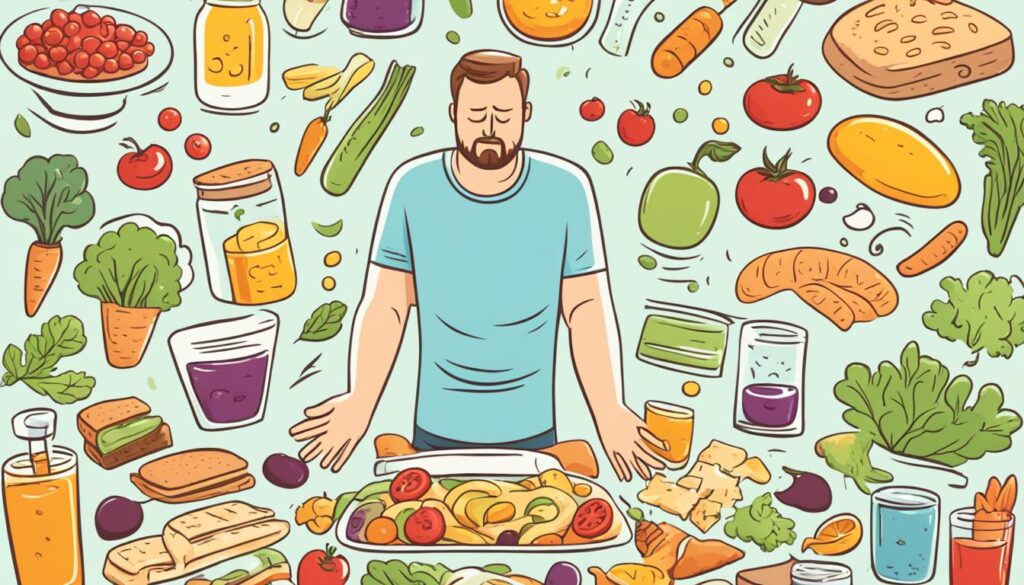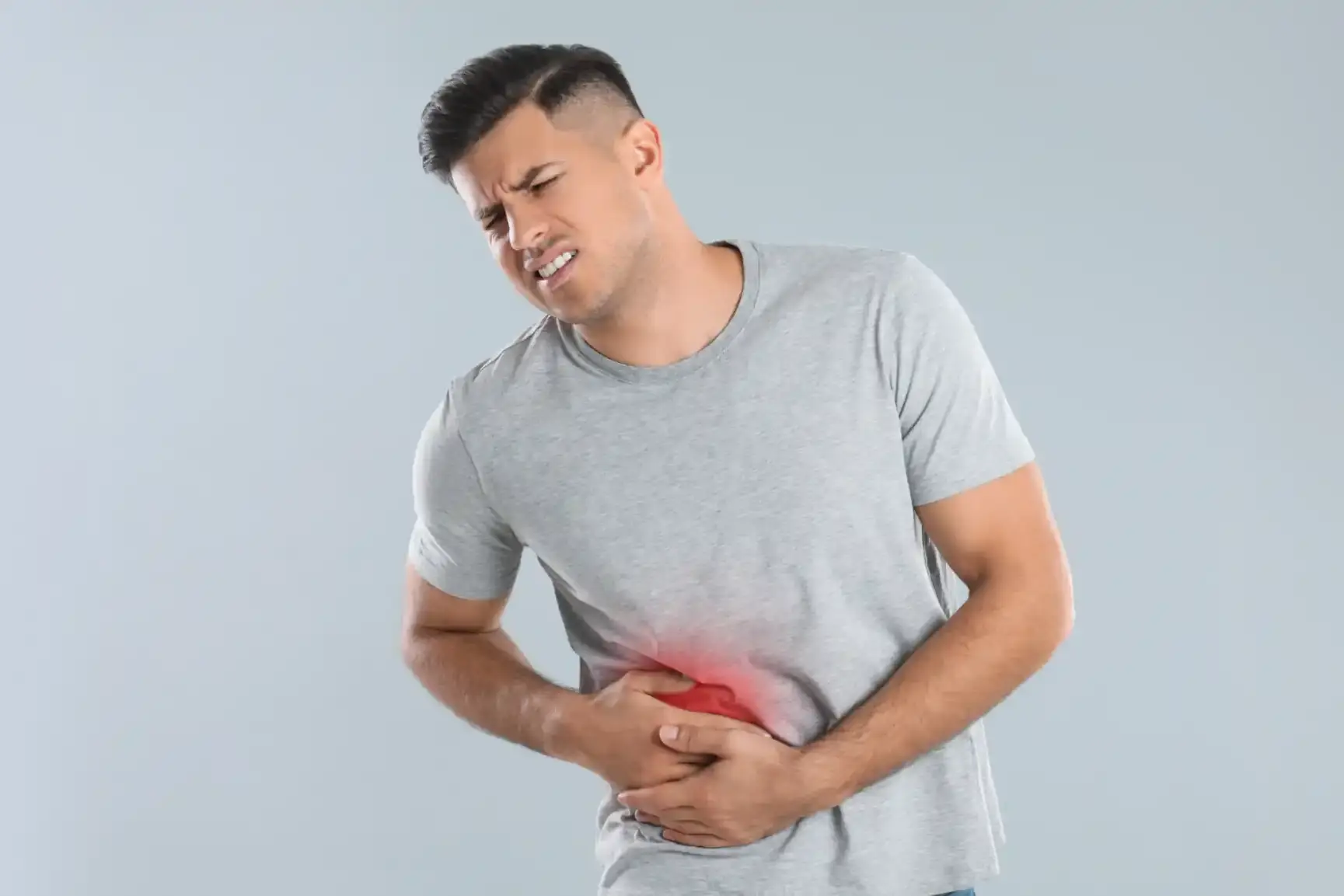Malabsorption is a term that covers many illnesses. It makes it hard for your body to take in nutrients from food. This can cause problems like indigestion and malnutrition. These aren’t due to a lack of eating well. They occur because your body can’t absorb nutrients properly.
Table of Contents
ToggleThe digestion process usually goes like this: food gets broken down, nutrients get absorbed, and waste gets out of your body. With malabsorption diseases, the middle part – absorbing nutrients – has trouble. This can be because of food intolerances, enzyme problems, or diseases that affect your gut.
People with malabsorption often feel sick, have diarrhea, and lack essential nutrients. Gastrointestinal diseases, issues with the pancreas, not enough enzymes, and past intestinal surgeries can cause malabsorption. It’s very important to get the right diagnosis and treatment to prevent more health issues.
What is Malabsorption?
Malabsorption covers many issues that stop you from getting needed nutrients from food. It can cause problems like indigestion and malnutrition. This happens when the body can’t absorb nutrients, not because you don’t eat enough.
Definition of Malabsorption
The digestive process takes in food, absorbs nutrients, and gets rid of what you don’t need. Malabsorption stops this process from working well, usually because of food intolerances or gut diseases. These issues make it hard for your body to break down food and use its nutrients.
Causes of Malabsorption
Many things can lead to malabsorption. These include gut diseases, problems with the pancreas, not enough enzymes, and past intestinal surgeries. Figuring out what’s causing malabsorption is key for treatment and prevention.
The Digestive Process and Malabsorption
Malabsorption messes up how your digestive system absorbs food’s nutrients. This disruption can cause symptoms and health issues if you don’t treat it. So, it’s important to address malabsorption to stay healthy.

Types of Malabsorption Diseases
Malabsorption makes it hard for the body to take in nutrients, causing different diseases. One example is carbohydrate malabsorption, known as sugar intolerance. It means your body can’t handle some sugars. This leads to problems like gas, bloating, and fatty stools.
Malabsorption of Carbohydrates
Carbohydrate malabsorption often comes from not having enough of a certain enzyme. A common example is lactose intolerance. If you’re lactose intolerant, you can’t digest lactose, the sugar in dairy. This causes issues like gas, pain, and upset stomach.
Fat Malabsorption
Fat malabsorption happens when your body struggles to digest and absorb fats right. It makes your stools oily and smelly. Plus, you might not be getting enough fat-soluble vitamins.
Bile Acid Malabsorption
Bile acid malabsorption is linked to not having enough bile to break down fats. Without enough bile, fats aren’t absorbed properly. This can lead to a condition where you have diarrhea a lot.
Protein Malabsorption
Protein malabsorption is not as common. It often happens because of certain food intolerances, like not being able to handle gluten or milk proteins. Symptoms include losing weight and feeling weak.
Various health issues can lead to malabsorption. From problems with the stomach and pancreas to lacking needed enzymes. Knowing about these different malabsorption types helps in figuring out and treating the problem.

Symptoms of Malabsorption
Malabsorption symptoms fall into two main groups. First, there are those tied to the gut. This includes things like chronic diarrhea, bloating, and smelly stools. The second group shows up as nutrient problems. These can lead to weight loss, tiredness, and even skin rashes.
Gastrointestinal Symptoms
Problems digesting and absorbing food can lead to a host of gut issues. This may mean diarrhea, bloating, or floating stools. Often, the body struggles with carbs, fats, and bile acids. This causes the gut symptoms.
Nutrient Deficiency Symptoms
When your body can’t absorb nutrients, you might not notice right away. But this can lead to serious issues. For example, vitamin or mineral shortages can cause weight loss or tiredness. It can even affect your skin and how you grow.
Loss of vitamins essential for a strong immune system, like vitamin A or zinc, can up your infection risk. So, if you keep having gut troubles or start seeing signs of nutrient loss, see a doctor. They can help diagnose and treat malabsorption.

Common Causes of Malabsorption
Malabsorption happens due to many reasons. These include diseases in the gut, issues with the pancreas, lack of certain enzymes, and surgeries on the intestines. Knowing what leads to this is key for treating and avoiding later problems.
Gastrointestinal Diseases
Some gut diseases hurt the intestines, not letting them absorb nutrients well. Illnesses like celiac disease, inflammatory bowel diseases, and cystic fibrosis fall into this category. They make it hard for the small intestine to take in important carbs, fats, and proteins.
Pancreatic Disorders
Conditions like chronic pancreatitis mess with making needed digestive enzymes. Without these enzymes, the body can’t break down and absorb fats, proteins, and fat-soluble vitamins properly.
Enzyme Deficiencies
Issues like lactose intolerance can also be at fault. They stop the body from breaking down and using certain nutrients, leading to gut troubles and not enough nutrients in the body.
Intestinal Surgeries
Surgeries on the small intestine can lower the area where nutrients can be absorbed. This might cause trouble taking in certain nutrients, depending on the surgery’s type and place.
malabsorption diseases
Malabsorption is a term covering disorders that affect food nutrient absorption. This includes carbs, fats, bile acids, and proteins. These conditions may cause various symptoms if untreated.
Celiac disease, tropical sprue, Crohn’s disease, and Whipple disease can lead to malabsorption. Deficiencies in pancreas enzymes also affect fat and nutrient absorption.
Other causes of malabsorption are AIDS/HIV, certain drugs, and surgeries, like gastrectomy. In kids, it can prevent them from gaining weight well. For adults, malabsorption shows as weight loss, muscle loss, and brain fog.
To diagnose, doctors use blood, urine tests, bowel biopsies, CT scans, and X-rays. Treatment focuses on the cause and proper nutrition. This might mean vitamin shots or special diets.
If not treated, malabsorption can cause serious issues like anemia and kidney stones. It’s important to stay in touch with your doctor and prevent disease based on its cause.
Diagnosing Malabsorption
The first step in managing malabsorption is finding its cause. Doctors use various tests to identify what’s behind your malabsorption issue. These tests look for problems with taking in carbs, fats, bile acids, or proteins.
Stool Tests
For a start, they might ask for a stool sample. This test shows if there’s too much fat or undigested food in your stool. It hints at what part of eating you might be having trouble with, like digesting or absorbing food right.
Breath Tests
Another test is the lactose hydrogen breath test. It’s good for checking if you have problems with carbs. After you eat something that might be hard for you, they look at the gases in your breath. This can tell them if you’re breaking down the food okay.
Biopsies
Sometimes, a small piece of your small intestine might need to be checked under a microscope. This is done by taking a biopsy. It can show if there’s any damage or disease that could be making it hard for your body to absorb nutrients.
Endoscopies
Endoscopies let the doctor look inside your digestive tract with a small camera. They can see if something’s wrong in there that’s making you not absorb food right. It’s a way to find out if there’s any damage or inflammation.
All these tests together help pin down what’s causing your malabsorption. Once they know, your healthcare team can plan treatment that’s just right for you.

Managing Malabsorption Disorders
Treating malabsorption disorders involves several steps. This includes changing what you eat, adding nutrients, and sometimes taking medicine. Managing the problem this way helps reduce symptoms and stops it from getting worse.
Dietary Changes
The first step is often changing your diet. For malabsorption disorders, you might need to cut out foods like lactose or gluten. This lessens stomach problems. It also makes your digestion work better by not eating foods that are hard for you to process.
Nutrient Supplementation
When you can’t absorb nutrients well, you might lack vitamins or minerals. Adding supplements can help fill this gap. Your doctor might suggest what to take, like vitamins that dissolve in fat or omega-3s.
Medication
Sometimes, medicine is necessary. It can treat the root cause of your malabsorption. This might include drugs that ease gut inflammation, enzymes to help digest food, or specific treatments. Your healthcare team will help you with the right medicine plan.
Following a complete plan including diet, supplements, and medicine can really help. It lets people with malabsorption lead healthier lives. They learn how to manage their condition and feel better overall.
Malabsorption in Children
Children can also have malabsorption, but their signs and treatments might not be the same as adults. Kids with this issue might not grow as they should, lose weight, and have trouble with development. Diagnosis and care are really important to help them grow well.
The reasons behind children’s malabsorption can be like those in grown-ups. It could be due to stomach or gut problems, issues with the pancreas, or not enough enzymes. For instance, cystic fibrosis and Shwachman-Diamond syndrome are born with and can make it hard for kids to digest food well. Even common conditions like lactose intolerance can play a part in hindering how kids absorb nutrients.
But, treating malabsorption in kids requires special attention to their specific needs. Things like slow enzyme growth in the pancreas of babies or the lack of bile acids in some very young kids are crucial. These factors make dealing with malabsorption in children a bit more complex.
Understanding the unique needs of children with malabsorption can be critical. Early diagnosis and a team effort from parents and doctors are key. They should work together on diets, pills, or whatever is needed to help the child grow and develop well. Keeping a close eye on their health and making changes as a team can go a long way.
Complications of Untreated Malabsorption
Dealing with malabsorption disorders is vital. The key is not ignoring it. If you leave this issue untreated, it can bring serious problems. This could change your overall health and how you feel.
Increased Infection Risk
When malabsorption is not treated, the chance of getting sick increases. Missing out on important nutrients can make your immune system weak. This makes you easier to catch illnesses and infections. This means you might get sick more often and more seriously, making malabsorption even harder to deal with.
Bone Health Issues
Badly absorbing nutrients affects your bone health, not just your overall health. Key nutrients like calcium and vitamin D are important for your bones. Without them, the risk of osteoporosis and fractures goes up. It becomes tough to keep your bones strong. This is when malabsorption is not handled well.
Growth and Development Concerns
For kids and teens, malabsorption can be a big problem for growing up. Not getting the right nutrients can stop or slow down their growth. It can also delay puberty and cause other issues. Helping them absorb nutrients well is key for their growth and health.
Preventing Malabsorption
Some reasons why malabsorption happens, like genetic issues, are hard to avoid. But you can lower the chance by eating well. This way, your body gets the nutrients it needs. Don’t overuse laxatives or antibiotics. They can upset your stomach, making proper digestion harder.
If you have ongoing stomach troubles like constant diarrhea or sudden weight loss, see a doctor. Getting help early can stop malabsorption issues from getting worse. This also prevents big problems that can come from untreated malabsorption.
Some kinds of malabsorption might be out of your control. But, you can still take steps to keep your gut healthy. Talking to your doctor about any fears you have helps a lot. It keeps you from getting sick and lets you live a full life.
Living with Malabsorption Disorders
If you have a malabsorption disorder, keeping healthy means doing a lot. You need to watch what you eat, see your doctor often, and find support. These steps are key to dealing with the effects of malabsorption every day.
Dietary Adjustments
Eating right is vital if you have a malabsorption disorder. You might need to cut out foods that are hard to digest, like those with lactose or gluten. A diet plan from your doctor can help ease your symptoms and make sure you still get the nutrients you need.
Regular Medical Monitoring
Keeping up with doctor visits is very important for anyone with a malabsorption disorder. You’ll get tests to check your nutrient levels and see if your treatment is working. Blood tests, stool samples, and other tests will help your doctors keep your care plan up-to-date.
Support Resources
Talking to others with malabsorption and getting info from doctors and groups can really help. They can give you tips on living with your disorder and offer emotional support. Doctors and online materials can also guide you in managing your health better.
Using the right diet, regular doctor visits, and support groups can help a lot. They let you take charge of dealing with your malabsorption and staying healthy and happy.
Conclusion
Malabsorption is a broad term for disorders that mess with how your body absorbs nutrients from food. This can cause stomach problems, lack of nutrients, and serious issues if not treated. Knowing about malabsorption and getting medical help can make a big difference in how you feel.
Doctors might use a mix of changes in what you eat, extra nutrients, and specific medicines to treat malabsorption. This approach aims to lessen symptoms by tackling the root problem. Working with your healthcare team is key to crafting a strategy that suits you.
Handling malabsorption involves looking at your health from many angles. You have support all around you to get through this. With the right help, you can beat the challenges and keep living well.
FAQ
What is malabsorption?
Malabsorption covers many disorders that affect nutrient absorption. It leads to issues like indigestion and malnutrition. This happens even if you eat well, due to not absorbing nutrients properly.
What causes malabsorption?
Gastrointestinal diseases, pancreas issues, and enzyme or surgery problems can cause malabsorption.
What are the different types of malabsorption diseases?
Malabsorption affects absorption of nutrients, causing its types. These include carbohydrate, fat, bile acid, and protein malabsorption diseases.
What are the symptoms of malabsorption?
Gastrointestinal issues include chronic diarrhea, bloating, and gas. Nutrient deficiencies show as weight loss, fatigue, and skin problems.
How is malabsorption diagnosed?
Diagnosis involves various tests like stool, breath, and endoscopies. Each helps look closer at your body’s absorption processes.
How is malabsorption managed?
Managing malabsorption uses diet changes, nutrient supplements, and medicines, all depending on the cause.
How does malabsorption affect children?
In children, malabsorption shows as growth delays and G.I. symptoms. Their diagnosis and treatment often vary from adults.
What are the complications of untreated malabsorption?
Not treating malabsorption can cause serious complications. It affects the immune system, bone health, and the growth of children.
How can malabsorption be prevented?
Prevention involves a balanced diet, side-effect awareness from medications, and prompt medical visits for stomach issues.
How can individuals living with malabsorption disorders manage their condition?
Management includes diet changes, regular check-ups, and working closely with healthcare teams and educational resources.
Source Links
- https://my.clevelandclinic.org/health/diseases/22722-malabsorption
- https://www.ncbi.nlm.nih.gov/books/NBK553106/
- https://www.mountsinai.org/health-library/diseases-conditions/malabsorption
- https://www.webmd.com/digestive-disorders/malabsorption-syndrome
- https://medlineplus.gov/malabsorptionsyndromes.html
- https://www.ncbi.nlm.nih.gov/pmc/articles/PMC7149679/
- https://emedicine.medscape.com/article/931041-overview
- https://www.healthline.com/health/malabsorption
About The Author

This article is medically reviewed by Dr. Nivedita Pandey, Senior Gastroenterologist and Hepatologist, ensuring accurate and reliable health information.
Dr. Nivedita Pandey is a U.S.-trained gastroenterologist specializing in pre and post-liver transplant care, as well as managing chronic gastrointestinal disorders. Known for her compassionate and patient-centered approach, Dr. Pandey is dedicated to delivering the highest quality of care to each patient.
→ Book a consultation to discover which remedies suit your needs best.
About Author | Instagram | Linkedin





